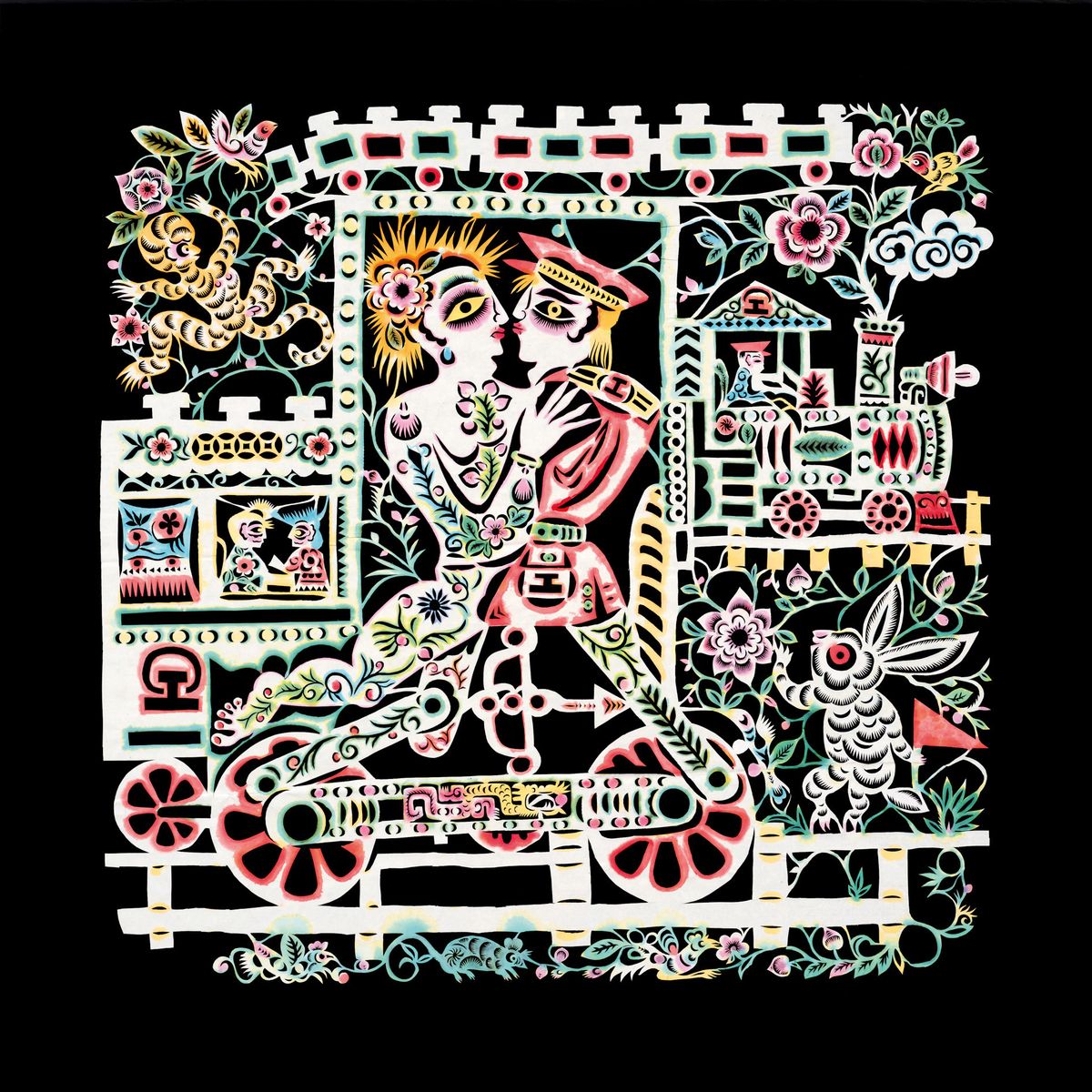Xiyadie: Butterfly Dream
Blindspot Gallery, 15/F, Po Chai Industrial Building, 28 Wong Chuk Hang Road, Wong Chuk Hang, Hong Kong, until 11 May
Two men entwined in an amorous embrace, a steamy encounter on a train and a debaucherous orgy in a bathhouse—you might not expect these scenes to be portrayed in any traditional art form, let alone in an ancient Chinese paper-cutting technique dating back to the second century. But the self-taught paper-cut artist Xiyadie playfully defies established norms: his signature works blend fantasy and real life as he charts his experiences as a gay man and migrant worker in China.
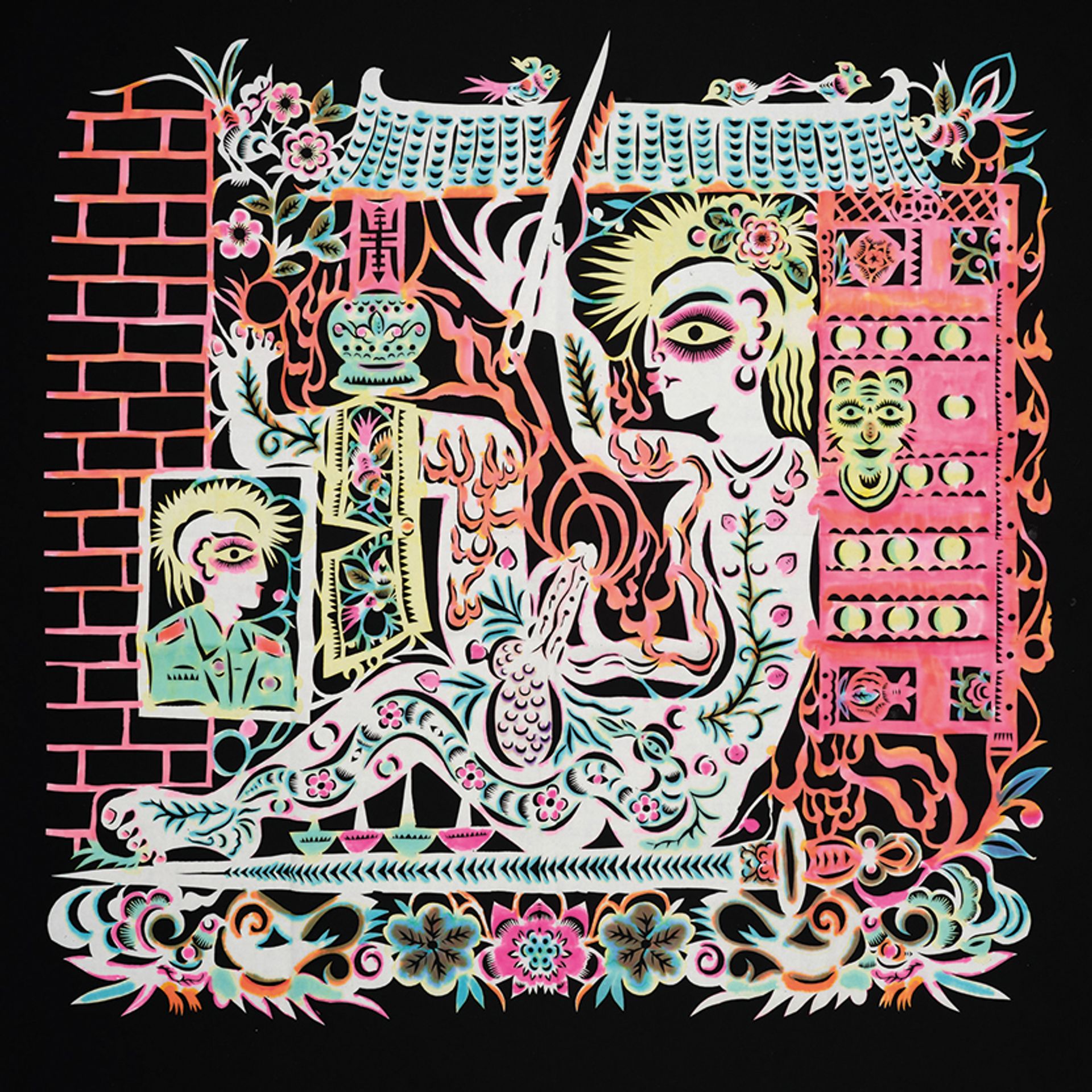
Hoping (2001) Courtesy of the artist and Blindspot Gallery
“His status as an outsider artist is rare in China,” says Mimi Chun, the founder of Blindspot Gallery in Hong Kong, which is presenting Xiyadie’s largest exhibition to date. “When asked, he describes himself as a man from the ‘yellow soil land’, alluding to his identity as a farmer.” The show, titled Butterfly Dream, features more than 30 paper-cut works, including ones that have never been exhibited before.
Intricate and colourful, the pieces chronicle real incidents and challenges in the artist’s life. Train (1986) was inspired by Xiyadie’s first gay encounter and depicts the artist and a train attendant having sex in the latter’s cabin. The two figures are surrounded by passengers dining as well as various animals and decorative floral motifs typical of the northern Shaanxi paper-cutting technique that Xiyadie employs. Double Happiness (1982) puts a funny, queer twist on the fortuitous Chinese character that means “double joy” and is often used as a celebration symbol for weddings; here, it’s transformed it into a face and pair of penises.
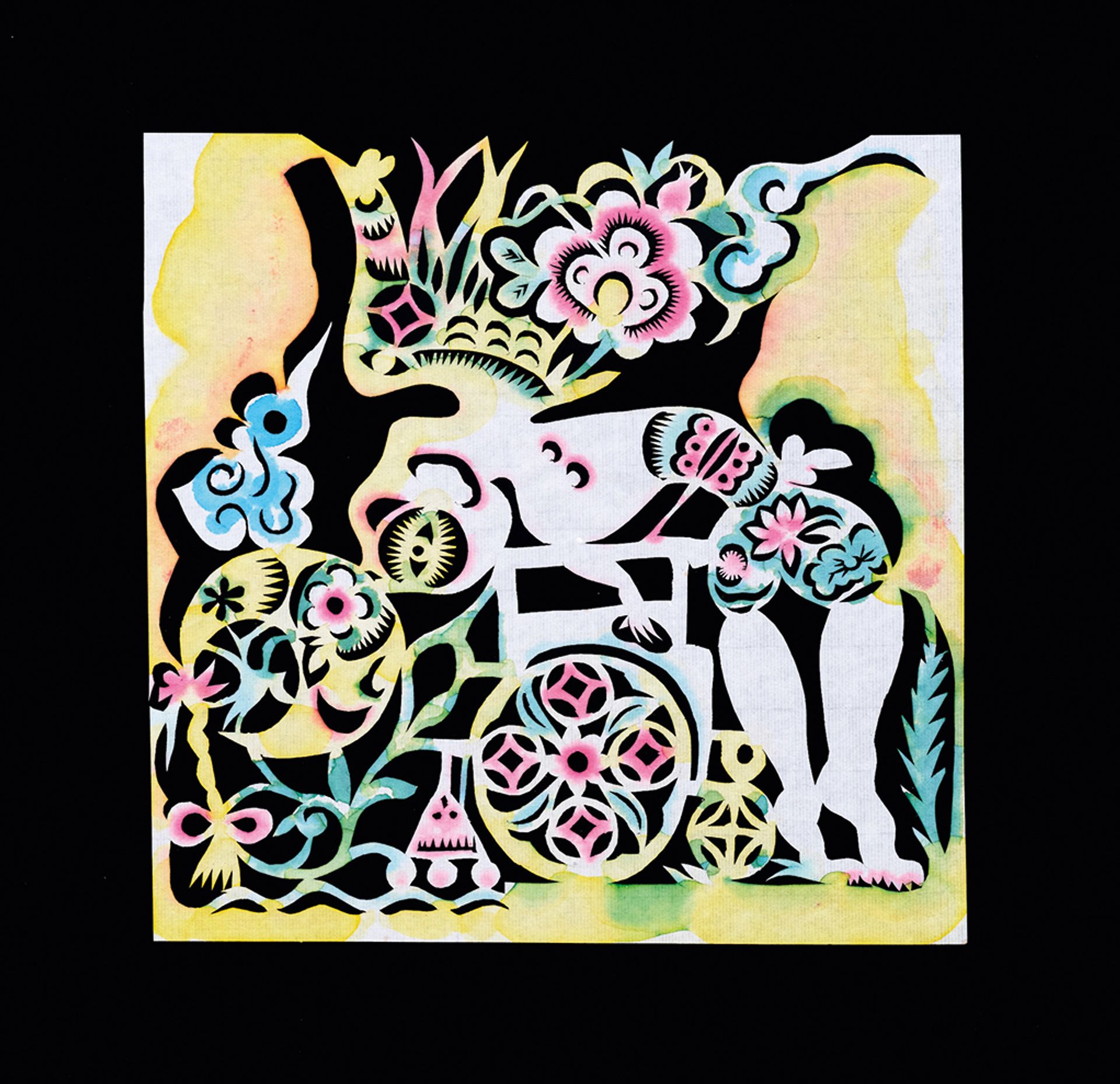
Sewn (1999) Courtesy of the artist and Blindspot Gallery
Sewn (1999) evokes a more visceral reaction, as the artist depicts himself sewing his genitals with a needle that is pushing through the roof of a traditional structure he seems to be trapped within. In Hoping (2000), Xiyadie imagines his son, who had cerebral palsy, taking flight from his wheelchair and turning into a butterfly, free from his condition.
Like his pseudonym, which means Siberian butterfly, Xiyadie’s practice has transformed over time. The artist compares the evolution of his artistic practice to a child learning how to walk. “Now, I’ve metamorphosed into an adult who can feel the outside world and inject these real-life experiences into my work,” he says. Art-making has been a therapeutic process for Xiyadie, offering a release of suppressed desires and a point of projection for his fantasies.
His artistic achievements blossomed as he embraced his sexuality, even while his domestic life appeared conventional. Born in a rural area of Shaanxi province, he moved to Beijing in 2005 as a migrant worker to earn more money for his son’s medical treatment. While the artist found a supportive and accepting LGBTQ community there, his son’s health deteriorated. Eventually, the boy passed away.
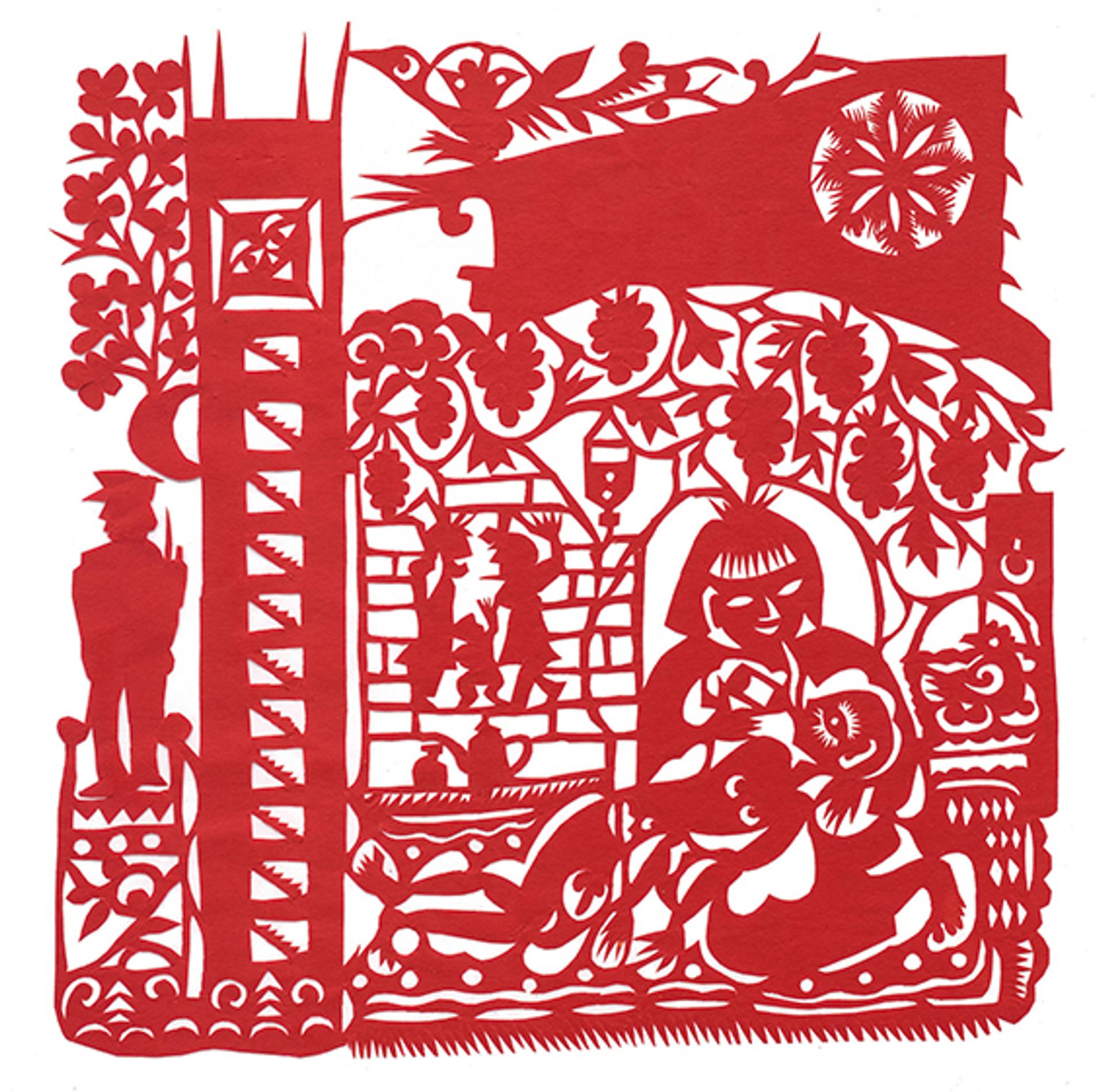
Missing, created in 2007, a traditional work on coloured Xuan paper Courtesy of the artist and Blindspot Gallery
Xiyadie had learned traditional paper-cutting techniques from his mother and female relatives when he was a teenager. Now, he crafts scenes in a singular style that infuses the popular folk art with his own lived experiences. “It takes months, years, or even longer, for me to experience life and contemplate life, in order to create an initial piece,” he says of the painstaking process.
Butterfly Dream builds on the artist’s successful solo exhibition Queer Cut Utopias, held last year at New York’s Drawing Center, and anticipates his participation in Foreigners Everywhere, the main exhibition of the forthcoming Venice Biennale, curated by Adriano Pedrosa. It promises to be a milestone moment for Xiyadie’s novel take on an age-old medium, highlighting a distinctive portrayal of gay intimacy in China that has been kept private for decades and can, at last, find a receptive audience.
Green Snake: women-centred ecologies
Tai Kwun, 10 Hollywood Road, Central, Hong Kong, until 1 April

Jaffa Lam’s Tin Hau is coming for a piece of water 2.0 (2023) Photo: Kwan Sheung Chi; courtesy of Tai Kwun
“We seem to be a land where animals, trees, women—everything is worshipped, and nothing is sacred,” the Indian writer and Times of India columnist Twinkle Khanna wrote on International Women’s Day, highlighting the paradox in not practising what you preach. While Khanna was referring to events in India, her statement seems to be applicable on a global level. This is the feeling one gets when visiting Green Snake: women-centred ecologies, an exhibition on view at Tai Kwun.
Curated by Xue Tan and Kathryn Weir, Green Snake features around 60 works spread across three rooms in Tai Kwun’s JC Contemporary galleries. It is a conceptually dense yet visually light presentation that draws on mythological practices and Indigenous traditions. A topical show, it fuses ecological and feminist issues, aiming to strike a chord with both the art world crowd and mainstream visitors.

Dima Srouji’s The Red River (2023) Photo: Kwan Sheung Chi; courtesy of Tai Kwun
Bringing together approximately 30 artists and collectives from 20 countries—including many from South America and other parts of Asia—the curators conceived the exhibition with local audiences in mind. “It’s about time we look outside of Hong Kong and try to think about and understand similar struggles and how [others] cope with these issues,” Tan says. “But it’s necessary to find a point of connection that will link these similarities with local audiences.”
To this end, the exhibition’s name draws on a well-known eighth-century Chinese folktale, Legend of the White Snake or Madame White Snake, which features two spirit sisters, one of whom has come to represent the idea of transformation and feminine power.
One of the works included in the show, Tin Hau is coming for a piece of water 2.0 (2023), is a sculptural installation by the Hong Kong artist Jaffa Lam which strongly reflects the show’s theme. Combining two familiar local references—land reclamation and the goddess of the sea Tin Hau—Lam suspends a piece of volcanic rock in a narrow staircase corridor connecting two rooms in the space’s main gallery. The rock symbolises a floating version of the deity, which the artist conceived after seeing multiple temples dedicated to Tin Hau being demolished due to land reclamation (Tin Hau’s temples are typically on or near bodies of water).
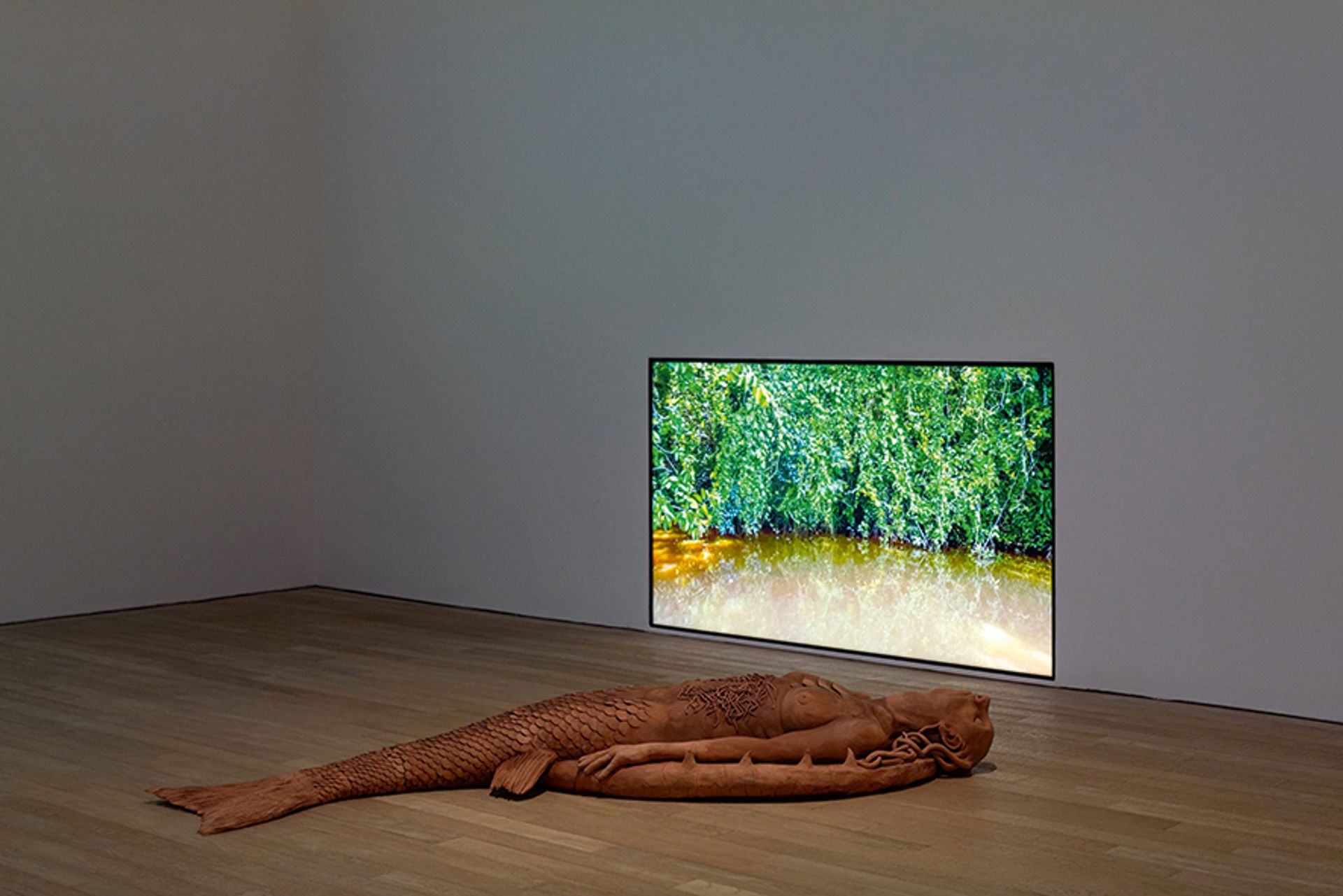
Pejerreina (2023), by the Argentinian artist Adriana Bustos Photo: Kwan Sheung Chi; courtesy of Tai Kwun
The interplay between strength and fragility, meanwhile, is a theme in the Palestinian artist and architect Dima Srouji’s The Red River (2023), an installation made up of small, red, hand-blown glass sculptures, suspended in the shape of a bending river. Their colour is symbolic of the pollution-induced changes in the river known to the Romans as the Belus, which is in north-western Israel. The stream was reportedly also the source of the sand first used for producing glass objects. The work carries a personal dimension for the artist, relating to her grandmother’s displacement, as well as an historical memory linked to the glass figure of the Canaanite goddess Astarte found at the site. Like Tin Hau, Astarte endures despite modern societal changes and disruptions.
“We wanted to build on the notion of care and the role that women play in facilitating that care, whether it’s [for] their families or communities,” Tan says. “It’s also about placing women as the vessel or link to the environment. Different worldviews place women at the centre and acknowledge the interdependency and interconnectivity we have with each other and nature. It’s only through this connected way that we can move forward and cope with ecological crises.”
The show provides a range of cultural perspectives on ecofeminism, highlighting the traditions and customs that were once considered to be sacred. At the same time, it proposes that a healing and re-learning process needs to take place before we can move forward and reimagine a greener future.
Aaina Bhargava
Another Day in Hong Kong
Asia Art Archive, 11/F Hollywood Centre, 233 Hollywood Road, Sheung Wan, until 31 August
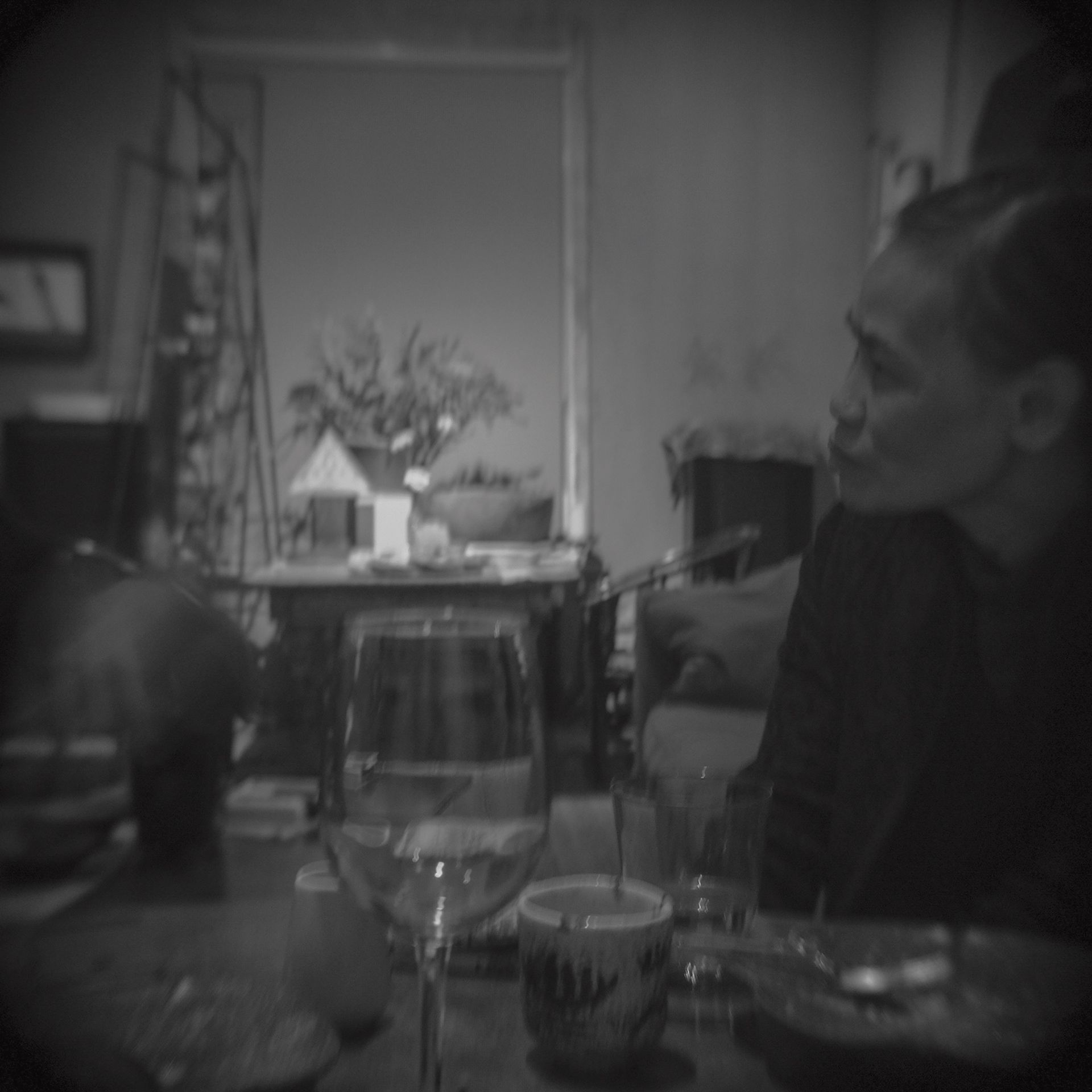
A self-portrait of Holly Lee, one of the participating artists in the Asia Art Archive exhibition Courtesy of the artist
Much of history is made up of mundane and unromantic moments, suggests Asia Art Archive’s (AAA) latest exhibition, Another Day in Hong Kong. The project attempts to reconstruct memories of a single day in the city: 19 October 1996, chosen because it represents the median date of works in AAA’s Hong Kong collections. In dialogue with materials from the archives, interviews, sound and video fragments will be new works created by six local artists and groups: KK Cheung, Florence Lam, Lee Ka Sing and Holly Lee, the duo To & Ling Are Covering Their Ears (To Yeuk and Lai Chun Ling), Siu King Chung and Ocean Leung.
The concept alludes to the artist and curator Oscar Ho’s 1990 exhibition A Day in Hong Kong, which presented photographs taken by Hong Kongers of their everyday experiences on 7 September that year. Inspiration also came from the Soviet-era phrase, “the future is certain; it is the past which is unpredictable,” says AAA’s senior researcher Anthony Yung, who co-organised the show with Hazel Kwok. Memory itself is the subject: more than simply recalling events that happened in the past, Yung says, hindsight means having a nuanced understanding of “how people at that time imagined their future”.
Apichatpong Weerasethakul: Primitive
The Studio, M+, West Kowloon Cultural District, 38 Museum Drive, Kowloon, until 14 July

Apichatpong Weerasethakul’s Ghost Teen (detail, 2009), from the artist’s Primitive project, which focuses on the lives of young people in a village in a troubled area of northern Thailand © the artist, image courtesy of the artist
The Thai artist and filmmaker Apichatpong Weerasethakul will take over M+’s Studio gallery for a new presentation of Primitive (2009), an intimate view into the lives and dreams of teenagers in the village of Nabua in northern Thailand, where the Mekong river demarcates the border with Laos.
Nabua has a harrowing past: the Thai military occupied the area from the 1960s to the early 80s to purge Communists—a label applied to many local farmers even though they did not necessarily know what the word meant. Weerasethakul layers that history of violence over an ancient legend, still believed by some in the countryside, of a widow ghost who abducts local men.
Presenting two video works on multiple screens as well as an artist’s book, Primitive is a project that draws out long-forgotten memories of turmoil and hints at the hope that the sons and grandsons of the persecuted farmers can build a new world.
Glenn Ligon
Hauser & Wirth Hong Kong, G/F, 8 Queen’s Road Central, Central, until 11 May
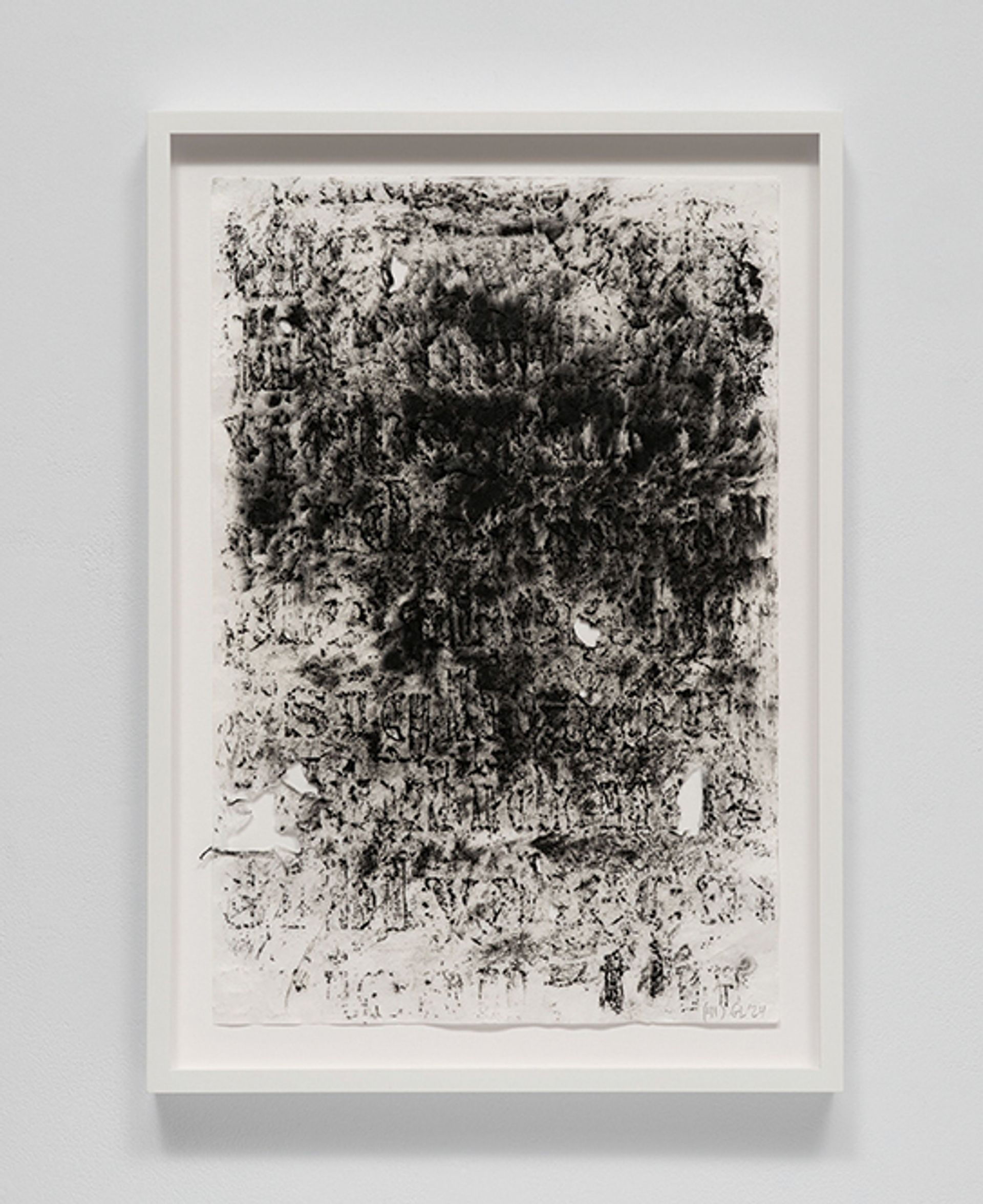
Untitled #41, one of Glenn Ligon’s new works that references the American writer James Baldwin’s essay Stranger in the Village Photo: Thomas Barratt; © the artist, courtesy of the artist and Hauser & Wirth
Glenn Ligon’s first solo show in greater China presents several new works in the Stranger series, which transforms excerpts of text by the Black author and civil rights activist James Baldwin into monumental paintings. Since its inception in 1997, the series has become one of Ligon’s most celebrated bodies of work, an ongoing tribute to Baldwin’s seminal 1953 essay Stranger in the Village. Written during the writer’s stay in a remote spa resort in Switzerland, the text draws parallels between his feelings of alienation in the village and as a Black man in America. In Ligon’s powerful compositions, Baldwin’s words are stencilled on the canvas and blurred together under layers of black coal dust. Hauser & Wirth Hong Kong will also show new abstract paintings and drawings by the artist that similarly mine fragments of Baldwin’s essay.
Aki Sasamoto: Sounding Lines
Para Site, 22/F, Wing Wah Industrial Building, 677 King’s Road, Quarry Bay, until 28 July
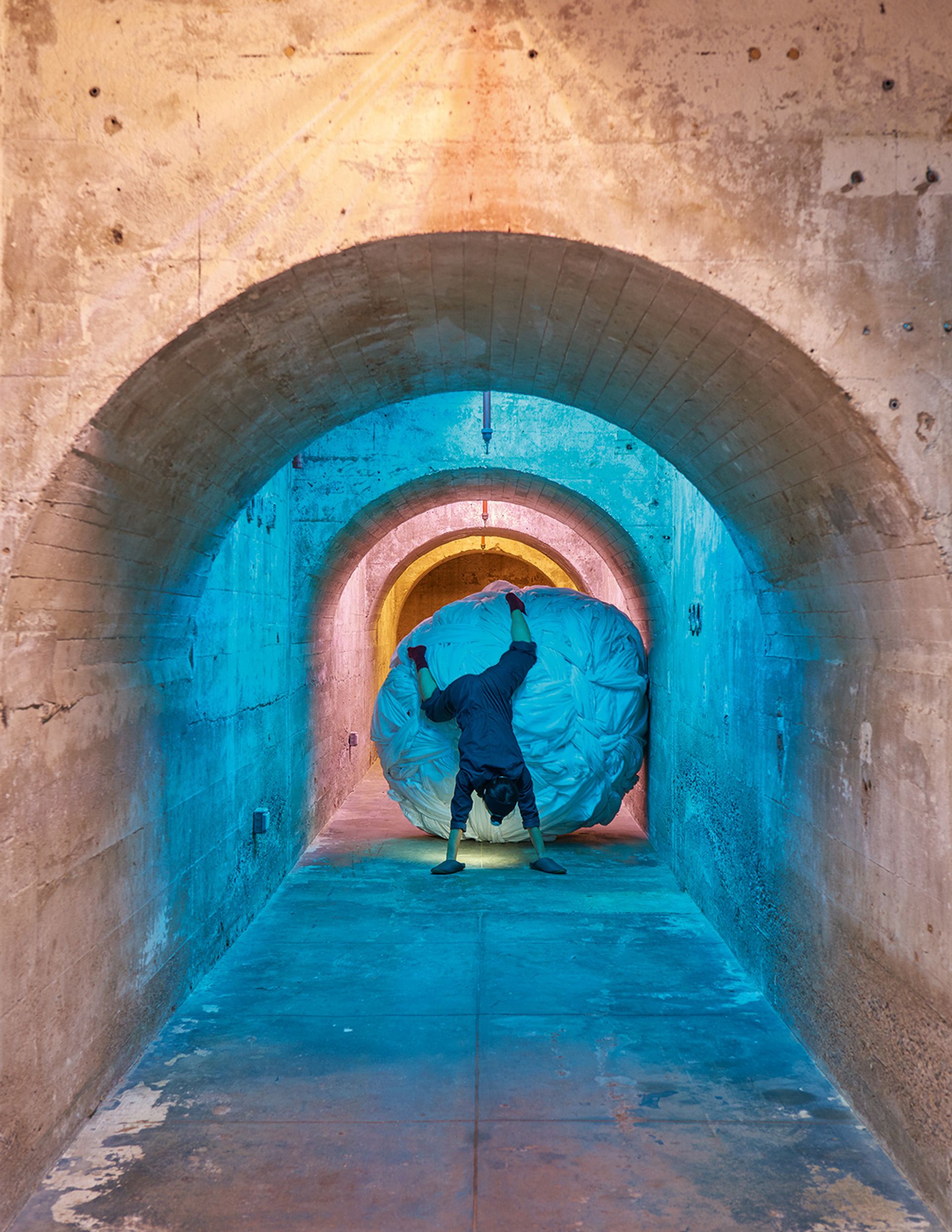
Delicate Cycle (2016) by Aki Sasamoto, in her show Sounding Lines at Para Site Courtesy of Take Ninagawa, Tokyo
Whether she is squeezing her body into a washing machine or bouncing on a trampoline inside a waste bin, the New York-based Japanese artist Aki Sasamoto is known for her absurdist, often comical performances reflecting on everyday life. For her first major show in Hong Kong, Sasamoto takes over Para Site with a room-sized installation where she will perform live. The exhibition’s title, Sounding Lines, alludes to a method of measuring the depth of the ocean using a weighted rope, which Sasamoto uses as a point of departure to explore the literal and figurative distances that exist between people. She has created a web of coiled metal springs and hung everyday objects, mimicking fishing lures, around the gallery space. A motorised mechanism activates these items, creating a choreography of sudden movements. Within this strange setting, Sasamoto confronts viewers with a raw performance on intimacy, separation and the dilemmas of human relationships.
Wong Kit Yi: +852 GHOST-JPG
Property Holdings Development Group (PHD Group), Goose Neck Bridge, Wan Chai, Hong Kong, until 4 May
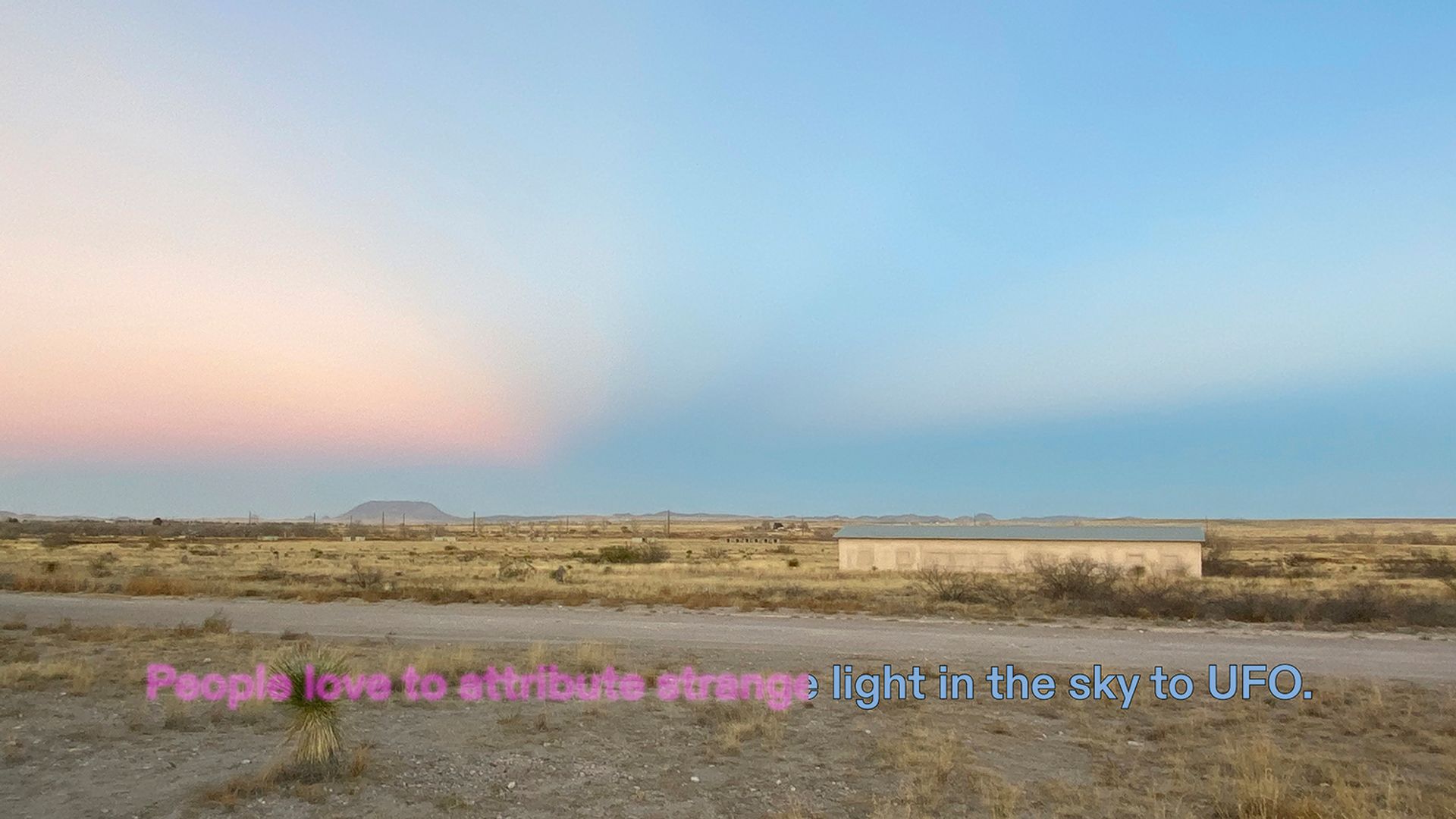
Wong Kit Yi’s video work Dial 432 to See the Light (2022-24) is part of her first solo show at PHD Group, which is running until early May Courtesy the artist, The Chinati Foundation and PHD Group
The Hong Kong-born artist Wong Kit Yi creates speculative video works with subtitles that light up like sing-along karaoke lyrics. Her process often begins with site-specific research from which she weaves a complex web of associations. At the heart of this solo show is 2022’s Dial 432 to See the Light, a poetic piece inspired by her residency at The Chinati Foundation in Marfa, Texas. The work begins with musings about the Chinese railroad labourers who worked in the area in the 19th century, but soon takes viewers down a rabbit hole exploring tangential topics such as bagpipe funeral music and the spiritual potential of sound frequencies. Wong will perform several “karaoke lectures” with various artists and curators who will read out the video’s subtitles. A living room-like installation of sand-coated sofas and ghost images (a screen malfunction where a faint image remains stuck) acts as a physical extension of the video and an eerily evocative set for the performances.
Tsai Ming-liang: The Monk from Tang Dynasty
Tai Kwun, 10 Hollywood Road, Central, Hong Kong, 29 March-1 April
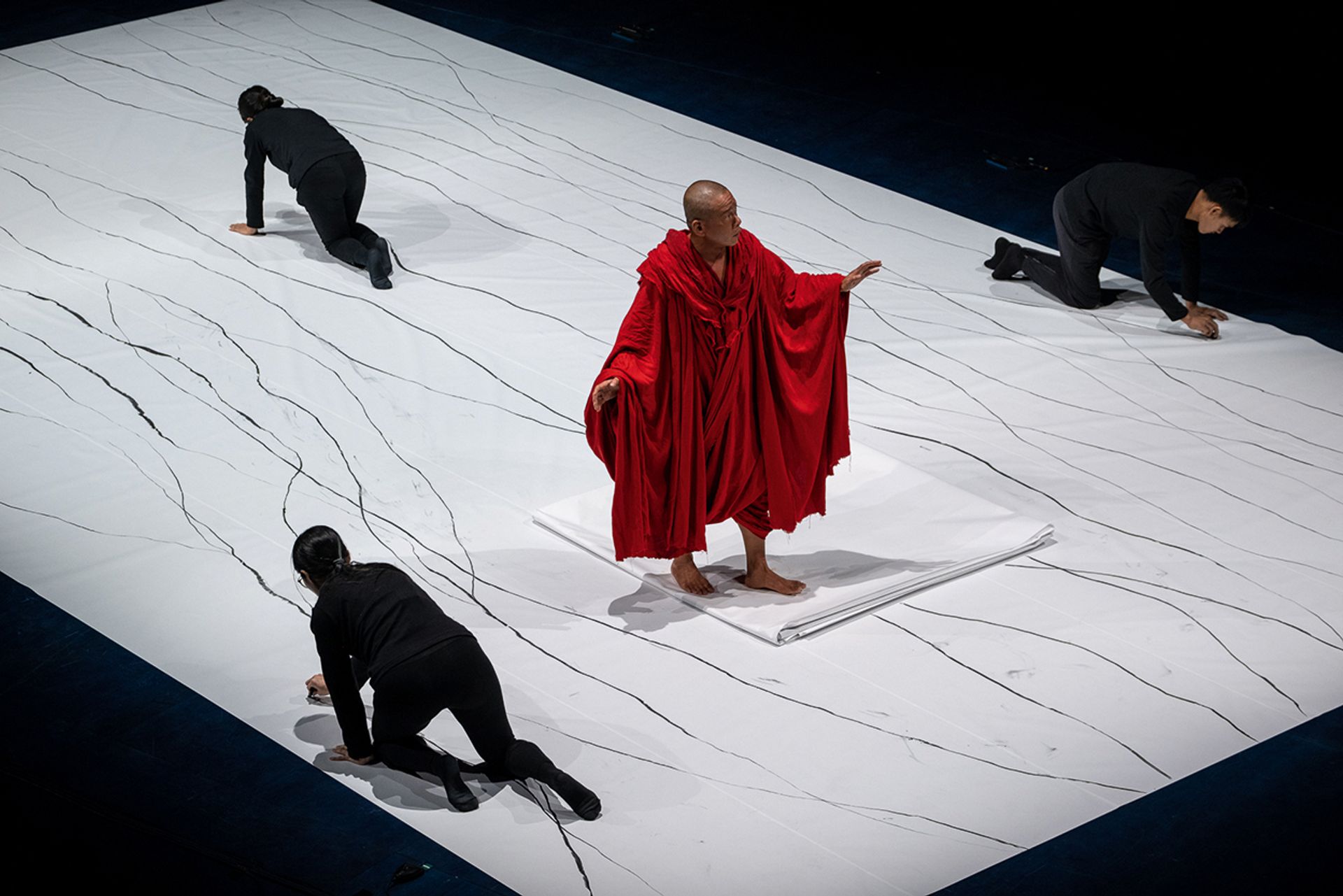
Director Tsai Ming-liang’s play The Monk from Tang Dynasty, based on the classic folk tale Journey to the West, is at Tai Kwun for three nights only Courtesy of Tai Kwun
Xuanzang, a seventh-century Buddhist monk and scholar, is best known through the dramatisation of his deeds in Journey to the West, the classic Ming dynasty novel that entangles his epic pilgrimage to India with mythology and folklore. The Taiwan-based Malaysian filmmaker Tsai Ming-liang regards Xuanzang as a “rebel” and has made him the lone character of his experimental play, The Monk from Tang Dynasty. The production has been adapted for its Hong Kong premiere at Tai Kwun’s semi-outdoor space, Laundry Steps, where it is being staged for three nights. The Taiwanese actor Lee Kang-sheng, Tsai’s longtime collaborator, will play Xuanzang in distressed red robes. His slow and silent movements will blend theatrical performance with installation art. The audience is encouraged to leave their seats and amble around the set as the performance unfolds, which forces them to slow down and absorb the monk’s concentrated energy. Think of it as a chance to detox from the frenetic pace of Asia’s largest art fair.


